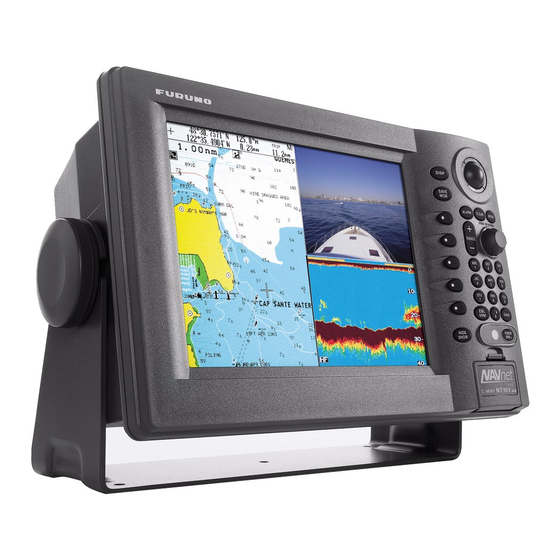Table of Contents
Advertisement
Quick Links
Advertisement
Table of Contents
Troubleshooting

Summarization of Contents
IMPORTANT NOTICES
General
Operator guidance and warranty considerations for equipment use.
How to discard this product
Guidance on proper disposal of the product according to local regulations.
How to discard a used battery
Instructions for the disposal of used batteries, emphasizing terminal protection.
SAFETY INSTRUCTIONS
WARNING (ELECTRICAL SHOCK HAZARD)
Precautions to prevent electrical shock, advising against opening the equipment.
WARNING (Radio Frequency Radiation Hazard)
Information on RF energy exposure from the radar antenna and safe operating distances.
1. OPERATIONAL OVERVIEW
1.1 Operating Controls
Detailed explanation of the display unit's controls, including soft keys, ENTER knob, and Trackball.
1.3 Turning the Unit On/Off
Instructions for powering the unit on and off, including startup sequence and shutdown procedures.
1.4 Display Brilliance, Panel Brilliance, Hue
Guide to adjusting screen brightness, panel brightness, and display color hue.
1.5 Selecting a Display
Options for choosing different display modes like full-screen, combination, and overlay screens.
1.8 Data Boxes
How to show, hide, and rearrange data boxes on the display for navigation information.
2. RADAR OPERATION
2.1 Radar Display
Description of the radar display layout, including key indicators and symbols.
2.4 Adjusting the Gain
Guide to adjusting radar receiver gain sensitivity for optimal echo detection.
2.5 Reducing Sea Clutter
Explanation and adjustment of the A/C SEA control to mitigate sea clutter.
2.9 Presentation Mode
Details on selecting display modes: head-up, course-up, north-up, and true motion.
2.10 Measuring the Range
Methods for measuring target range using range rings, cursor, or VRM.
2.22 Guard Alarm
Setting up guard zones to detect targets entering or leaving specific areas.
2.26 ARP, TTM Operation
Acquiring and tracking targets using the ARP/TTM function for collision avoidance.
2.27 Interpreting the Radar Display
Understanding various radar display phenomena like false echoes and interference.
3. PLOTTER OPERATION
3.1 Plotter Displays
Overview of available plotter display types including full-screen, combination, and overlay.
3.5 Chart Cards
Information on using Navionics GOLD and C-MAP chart cards.
3.8 Waypoints
Entering, editing, erasing, and searching for waypoints on the plotter.
3.9 Routes
Creating, connecting, inserting, removing, and erasing routes for navigation.
3.10 Navigation
Guidance on navigating to destinations using quick points, waypoints, and routes.
3.11 Alarms
Configuration and management of various plotter alarms like arrival, XTE, and grounding.
4. VIDEO SOUNDER OPERATION
4.1 Sounder Displays
Overview of available sounder display modes: dual frequency, single frequency, and zoom.
4.3 Manual Sounder Operation
Adjusting gain, range, and range shift for manual sounder operation.
4.11 Alarms
Setting up sounder alarms for bottom, fish, and temperature conditions.
4.15 Interpreting the Sounder Display
Understanding sounder display elements like zero line, bottom echo, and fish school echoes.
5. AIS OPERATION
5.1 Turning AIS Feature On/Off
Instructions for enabling or disabling the AIS feature and configuring its options.
5.7 Setting CPA and TCPA
Configuring Closest Point of Approach (CPA) and Time to CPA (TCPA) alarms.
5.8 Proximity Alarm
Setting up proximity alarms for AIS targets approaching the vessel.
6. DATA TRANSFER
6.1 Memory Card Operations
Procedures for managing data on memory cards, including saving and deleting.
6.2 Uploading, Downloading Data
Steps for transferring data between the unit and a PC via communication software.
6.4 Receiving Data Via Network Equipment
How to receive waypoints, routes, marks, and lines from other NavNet equipment.
7. CUSTOMIZING YOUR UNIT
7.1 General Setup
Configuring common unit settings like language, units, and display options.
7.2 Radar Setup
Customizing radar display settings, including display, range, and function keys.
7.3 Plotter Setup
Setting up plotter display options, navigation, chart attributes, and data boxes.
7.9 Sounder Setup
Customizing sounder settings for fish alarms, sensors, and display ranges.
8. MAINTENANCE, TROUBLESHOOTING
8.1 Preventive Maintenance
Regular maintenance procedures for display unit connectors, LCD, and ground terminal.
8.7 Simple Troubleshooting
Step-by-step troubleshooting for common issues with the unit, radar, plotter, and sounder.
8.10 Clearing Memories
How to clear unit memories to reset operation to default settings.
8.11 Error Messages
Explanation of error messages and their corresponding remedies for troubleshooting.
SPECIFICATIONS OF MARINE RADAR MODEL 18x4C/19x4C SERIES
1 GENERAL
General specifications including range, pulse length, and pulse repetition rate.
2 ANTENNA UNIT
Technical specifications for the antenna units of different radar models.
3 TRANSCEIVER MODULE
Details on the transceiver module's frequency, power, and tuning capabilities.
SPECIFICATIONS OF VIDEO PLOTTER GD-1920C
1 PLOTTER FUNCTION
Specifications related to plotter functions like projection, area, pixels, and track display.
3 ENVIRONMENTAL CONDITION
Operational environmental specifications including ambient temperature and waterproofing.
4 COATING COLOR
Specifications for the coating color of the display unit and antenna unit.












Need help?
Do you have a question about the NAVNET VX2 1964C and is the answer not in the manual?
Questions and answers